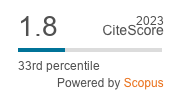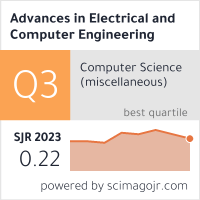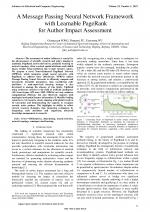| 1/2025 - 2 |
A Message Passing Neural Network Framework with Learnable PageRank for Author Impact AssessmentSONG, G. |
| Extra paper information in |
| Click to see author's profile in |
| Download PDF |
Author keywords
bibliometrics, data mining, neural networks, network topology, semisupervised learning
References keywords
rank(12), networks(7), science(5), ranking(5), personalized(5), information(5), citation(5), index(4), algorithm(4)
Blue keywords are present in both the references section and the paper title.
About this article
Date of Publication: 2025-02-28
Volume 25, Issue 1, Year 2025, On page(s): 11 - 20
ISSN: 1582-7445, e-ISSN: 1844-7600
Digital Object Identifier: 10.4316/AECE.2025.01002
SCOPUS ID: 86000344468
Abstract
The assessment of author influence is crucial for the advancement of scientific research and policy shaping in academia. PageRank and its derivatives, primarily focusing on network topology, often overlook spatial attributes and exhibit biases, besides being inefficient due to their iterative nature. We propose a novel Neuro-Enhanced PageRank Network (NPRNet), which integrates graph neural networks with PageRank to address these deficiencies. NPRNet utilizes Message Passing Neural Networks to efficiently compute and incorporate learnable parameters, thus considering node attributes. A semi-supervised learning strategy is also developed to manage the absence of true labels. Validated using conference articles in the field of artificial intelligence (AI) from Scopus API since 1985, NPRNet not only enhances computational efficiency but also effectively captures both topological and spatial feature information. It identifies leading countries in AI research, closely aligning with global trends in AI innovation and demonstrating the capacity to recognize recently active authors. This highlights its ability to reflect current research dynamics, thus deepening evaluations by integrating node attributes and supporting advanced knowledge management in research. |
| References | | | Cited By «-- Click to see who has cited this paper |
| [1] Y. Zhang, M. Wang, M. Zipperle, A. Abbasi and M. Tani, "Relrank: A relevance-based author ranking algorithm for individual publication venues," Information Processing amp; Management, vol. 60, p. 103156, 2022. [CrossRef] [Web of Science Times Cited 7] [SCOPUS Times Cited 7] [2] X. Jiang, X. Sun and H. Zhuge, "Graph-based algorithms for ranking researchers: Not all swans are white!," Scientometrics, vol. 96, pp. 743-759, 2013. [CrossRef] [Web of Science Times Cited 21] [SCOPUS Times Cited 23] [3] K. Balog, L. Azzopardi and M. de Rijke, "Formal models for expert finding in enterprise corpora," in Proceedings of the 29th annual international ACM SIGIR conference on Research and development in information retrieval, 2006. [CrossRef] [SCOPUS Times Cited 470] [4] E. Garfield, "Citation analysis as a tool in journal evaluation," Science, vol. 178, pp. 471-479, 2006. [CrossRef] [SCOPUS Times Cited 2169] [5] H. Deng, J. Han, M. R. Lyu and I. King, "Modeling and exploiting heterogeneous bibliographic networks for expertise ranking," 2012, pp. 71-80. [CrossRef] [SCOPUS Times Cited 51] [6] D. S. Gupta and D. S. Gupta, "An index to quantify global world educational's engineering and medical scientific research output," International journal of Emerging Trends in Science and Technology, vol. 3, no. 05, pp. 3968-3977, 2016. [CrossRef] [7] L. Egghe, "Theory and practise of the g-index," Scientometrics, vol. 69, no. 1, pp. 131-152, 2006. [CrossRef] [Web of Science Times Cited 1613] [SCOPUS Times Cited 1852] [8] M. Bras-Amoros, J. Domingo-Ferrer and V. Torra, "A bibliometric index based on the collaboration distance between cited and citing authors," Journal of Informetrics, vol. 5, pp. 248-264, 2010. [CrossRef] [Web of Science Times Cited 39] [SCOPUS Times Cited 43] [9] G. Mustafa, A. Rauf and M. T. Afzal, "Gk index: Bridging Gf and K indices for comprehensive author evaluation," Knowledge and Information Systems, vol. 4, pp. 1-36, 2024. [CrossRef] [Web of Science Times Cited 4] [SCOPUS Times Cited 2] [10] H. Zhuge and J. Zhang, "Topological centrality and its e-science applications," Journal of the American Society for Information Science and Technology, vol. 61, pp. 1824-1841, 2010. [CrossRef] [Web of Science Times Cited 48] [SCOPUS Times Cited 69] [11] F. A. Massucci and D. Docampo, "Measuring the academic reputation through citation networks via PageRank," Journal of Informetrics, vol. 13, pp. 185-201, 2019. [CrossRef] [Web of Science Times Cited 57] [SCOPUS Times Cited 66] [12] C. Ji, Y. Tang and G. Chen, "Analyzing the influence of academic papers based on improved PageRank," 2020, pp. 214-225. [CrossRef] [SCOPUS Times Cited 3] [13] A. Lubis and E. Prasiwiningrum, "Implementation of PageRank algorithm for visualization and weighting of keyword networks in scientific papers," Journal of Applied Data Sciences, vol. 4, pp. 382-391, 2023. [CrossRef] [SCOPUS Times Cited 1] [14] S. Brin and L. Page, "Reprint of: The anatomy of a large-scale hypertextual web search engine," Computer Networks, vol. 56, pp. 3825-3833, 2012. [CrossRef] [Web of Science Times Cited 377] [SCOPUS Times Cited 725] [15] S. Maslov and S. Redner, "Promise and pitfalls of extending googles PageRank algorithm to citation networks," The Journal of Neuroscience, vol. 28, pp. 11103-11105, 2008. [CrossRef] [Web of Science Times Cited 76] [SCOPUS Times Cited 87] [16] C. He, J. Wu and Q. Zhang, "Characterizing research leadership on geographically weighted collaboration network," Scientometrics, vol. 126, pp. 4005-4037, 2021. [CrossRef] [Web of Science Times Cited 23] [SCOPUS Times Cited 24] [17] M. A. Dayeh, B. Sartawi and S. Salah, "A bias-free time-aware PageRank algorithm for paper ranking in dynamic citation networks," Intelligent Information Management, vol. 14, pp. 53-70, 2022. [CrossRef] [18] F. Zhang and S. Wu, "Ranking scientific papers and venues in heterogeneous academic networks by mutual reinforcement," 2018, pp. 127-130. [CrossRef] [Web of Science Times Cited 9] [SCOPUS Times Cited 12] [19] S. Park, W. Lee, B. Choe and S.-G. Lee, "A survey on personalized PageRank computation algorithms," IEEE Access, vol. 7, pp. 163049-163062, 2019. [CrossRef] [Web of Science Times Cited 24] [SCOPUS Times Cited 35] [20] Z. Wei, X. He, X. Xiao, S. Wang, S. Shang, and J.-R. Wen, "TopPPR: top-k personalized PageRank queries with precision guarantees on large graphs," 2018, pp. 441-456. [CrossRef] [Web of Science Times Cited 56] [SCOPUS Times Cited 71] [21] M. Liao, R.-H. Li, Q. Dai and G. Wang, "Efficient personalized PageRank computation: A spanning forests sampling based approach," vol. 67, 2022, pp. 2048-2061. [CrossRef] [Web of Science Times Cited 9] [SCOPUS Times Cited 12] [22] R. Andersen, C. Borgs, J. Chayes, J. Hopcroft, V. Mirrokni and S.-H. Teng, "Local computation of PageRank contributions," Internet Mathematics, vol. 5, pp. 23-45, 2011. [CrossRef] [SCOPUS Times Cited 81] [23] S. Wang, Y. Tang, X. Xiao, Y. Yang and Z. Li, "HubPPR: Effective indexing for approximate personalized PageRank," Proceedings of the VLDB Endowment, vol. 10, pp. 205-216, 2017. [CrossRef] [SCOPUS Times Cited 71] [24] J. Shi, R. Yang, T. Jin, X. Xiao and Y. Yang, "Realtime top-k personalized PageRank over large graphs on GPUs," Proceedings of the VLDB Endowment, vol. 13, pp. 15-28, 2019. [CrossRef] [Web of Science Times Cited 21] [SCOPUS Times Cited 31] [25] J. Gilmer, S. S. Schoenholz, P. F. Riley, O. Vinyals and G. E. Dahl, "Neural message passing for quantum chemistry," in International conference on machine learning. PMLR, 2017, pp. 1263-1272. [CrossRef] [26] C. Burges, T. Shaked, E. Renshaw, A. Lazier, M. Deeds, N. Hamilton and G. Hullender, "Learning to rank using gradient descent," 2006, pp. 89-96. [CrossRef] [SCOPUS Times Cited 2197] [27] A. F. Rochim, T. N. Wijaya and D. Eridani, "A citation data collector tool of author's profiles in scopus based on web and application programming interface (API)," vol. 1077, 2021, p. 012017. [CrossRef] [28] P. Sen, G. Namata, M. Bilgic, L. Getoor, B. Galligher and T. Eliassi-Rad, "Collective classification in network data," AI magazine, vol. 29, pp. 93-93, 2008. [CrossRef] [Web of Science Times Cited 2382] [SCOPUS Times Cited 3162] Web of Science® Citations for all references: 4,766 TCR SCOPUS® Citations for all references: 11,264 TCR Web of Science® Average Citations per reference: 164 ACR SCOPUS® Average Citations per reference: 388 ACR TCR = Total Citations for References / ACR = Average Citations per Reference We introduced in 2010 - for the first time in scientific publishing, the term "References Weight", as a quantitative indication of the quality ... Read more Citations for references updated on 2025-06-04 19:22 in 188 seconds. Note1: Web of Science® is a registered trademark of Clarivate Analytics. Note2: SCOPUS® is a registered trademark of Elsevier B.V. Disclaimer: All queries to the respective databases were made by using the DOI record of every reference (where available). Due to technical problems beyond our control, the information is not always accurate. Please use the CrossRef link to visit the respective publisher site. |
Faculty of Electrical Engineering and Computer Science
Stefan cel Mare University of Suceava, Romania
All rights reserved: Advances in Electrical and Computer Engineering is a registered trademark of the Stefan cel Mare University of Suceava. No part of this publication may be reproduced, stored in a retrieval system, photocopied, recorded or archived, without the written permission from the Editor. When authors submit their papers for publication, they agree that the copyright for their article be transferred to the Faculty of Electrical Engineering and Computer Science, Stefan cel Mare University of Suceava, Romania, if and only if the articles are accepted for publication. The copyright covers the exclusive rights to reproduce and distribute the article, including reprints and translations.
Permission for other use: The copyright owner's consent does not extend to copying for general distribution, for promotion, for creating new works, or for resale. Specific written permission must be obtained from the Editor for such copying. Direct linking to files hosted on this website is strictly prohibited.
Disclaimer: Whilst every effort is made by the publishers and editorial board to see that no inaccurate or misleading data, opinions or statements appear in this journal, they wish to make it clear that all information and opinions formulated in the articles, as well as linguistic accuracy, are the sole responsibility of the author.



